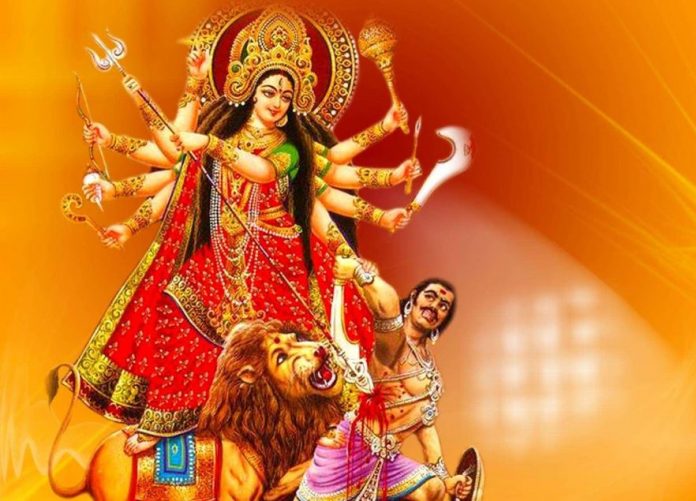Navaratri, is a Hindu festival that spans nine nights and is dedicated to the worship of the Goddess Durga in her various forms. The festival has great significance and is celebrated with devotion and enthusiasm in different parts of India. Here are some of the main significances of Navratri:
- Goddess Durga Worship: Navratri is primarily a celebration of the divine feminine in the form of Goddess Durga. During these nine nights, different forms of the Goddess are worshipped, and her divine energy and blessings are invoked.
- Victory of Good Over Evil: The festival commemorates the victory of Goddess Durga over the buffalo demon Mahishasura, symbolizing the triumph of good over evil. It is a reminder of the power of righteousness and the ultimate defeat of negativity.
- Durga Puja: In the eastern part of India, particularly West Bengal, Navratri is celebrated as Durga Puja, one of the most significant and elaborate festivals. It involves the creation of elaborate clay idols of the Goddess, cultural events, and grand processions.
- Nine Forms of the Goddess: Each of the nine nights is dedicated to one of the nine forms or manifestations of Goddess Durga, known as “Navadurga.” These forms represent different qualities and attributes of the divine feminine.
- Fasting and Penance: Many devotees observe fasts during Navratri as a form of penance and purification. Fasting is a way to cleanse the body and mind and seek the Goddess’s blessings.
- Cultural Celebrations: Navratri is not just a religious festival but also a time for cultural celebrations. In many parts of India, people participate in traditional dance forms like Garba and Dandiya, which are a significant part of the festivities.
- Harvest Festival: In some regions, Navratri also marks the end of the monsoon season and the beginning of the harvest season. People offer prayers for a bountiful harvest.
- Renewal of Faith: Navratri serves as a time for devotees to renew their faith and seek spiritual growth. It’s an opportunity to strengthen their relationship with the divine and to seek blessings for health, happiness, and prosperity.
- Community and Togetherness: The festival brings communities and families together as people gather to worship, dance, and celebrate. It promotes a sense of unity and togetherness.
Navratri is a vibrant and culturally rich festival that holds deep religious and spiritual significance for Hindus. It is celebrated with devotion, fervor, and a sense of joy, and it varies in traditions and customs across different regions of India.
Navratri is a nine-day festival celebrated with devotion and enthusiasm by Hindus. Each of the nine days has its significance and is dedicated to the worship of the Goddess Durga in her various forms. Here’s an overview of how each day of Navratri is celebrated:
- Day 1 – Pratipada: On the first day, Goddess Shailaputri, an incarnation of Parvati, is worshipped. She is believed to be the daughter of the Himalayas (Shaila).
- Day 2 – Dwitiya: The second day is dedicated to Goddess Brahmacharini, who symbolizes penance and devotion. Devotees seek her blessings for peace and happiness.
- Day 3 – Tritiya: On the third day, Goddess Chandraghanta is worshipped. She is depicted with a crescent moon on her forehead and is believed to symbolize courage and bravery.
- Day 4 – Chaturthi: This day is dedicated to Goddess Kushmanda, who is believed to have created the universe with her smile. She represents the cosmic source of energy.
- Day 5 – Panchami: On the fifth day, Goddess Skandamata, the mother of Lord Kartikeya (Skanda), is worshipped. Devotees seek her blessings for wisdom and knowledge.
- Day 6 – Shashti: The sixth day is dedicated to Goddess Katyayani, who is believed to be a fierce form of Durga. She is revered for her protection and courage.
- Day 7 – Saptami: On the seventh day, Goddess Kalratri, a fierce and dark form of Durga, is worshipped. She is believed to protect her devotees from harm and negative energies.
- Day 8 – Ashtami: The eighth day is devoted to Goddess Mahagauri, who symbolizes purity and serenity. Devotees seek her blessings for peace and forgiveness.
- Day 9 – Navami: The final day is dedicated to Goddess Siddhidatri, who is believed to fulfill the wishes of her devotees. It’s a day of prayer, reflection, and seeking the Goddess’s blessings.
These nine days are filled with fasting, prayers, cultural celebrations, and a sense of devotion. In different regions of India, Navratri is celebrated with various customs and traditions, such as Garba and Dandiya dance in Gujarat, and Durga Puja in West Bengal. It’s a time for spiritual growth, renewal of faith, and a sense of unity and togetherness in the community.
During the nine days of Navratri, devotees often follow a color code associated with each day, and they offer specific prasadam (food offerings) to the Goddess Durga. Here’s a list of the Navratri colors and some common prasadam offerings:
Day 1 (Pratipada):
- Color: Grey
- Prasadam: Usually, devotees offer milk and fruits as the prasadam on the first day.
Day 2 (Dwitiya):
- Color: Orange
- Prasadam: It is common to offer sugar and sweets like orange mithai (sweets) as prasadam on the second day.
Day 3 (Tritiya):
- Color: White
- Prasadam: Coconut is often offered as prasadam on the third day, along with other white sweets or foods.
Day 4 (Chaturthi):
- Color: Red
- Prasadam: On the fourth day, devotees often offer red foods, like jaggery or sweet dishes, as prasadam.
Day 5 (Panchami):
- Color: Royal Blue
- Prasadam: The prasadam on the fifth day may include curd and dishes made from milk products.
Day 6 (Shashti):
- Color: Yellow
- Prasadam: On the sixth day, devotees typically offer dishes made from yellow lentils (e.g., moong dal) and yellow sweets as prasadam.
Day 7 (Saptami):
- Color: Green
- Prasadam: On the seventh day, green leafy vegetables, and green chutneys are often offered as prasadam.
Day 8 (Ashtami):
- Color: Peacock Green
- Prasadam: Devotees may offer kheer (rice pudding) and other sweet dishes as prasadam on the eighth day.
Day 9 (Navami):
- Color: Purple
- Prasadam: On the final day, purple-colored foods or purple fruits are offered as prasadam to the Goddess.
Please note that while these colors and prasadam offerings are commonly associated with Navratri, the customs and traditions may vary among different regions and communities. It’s essential to follow the customs that are prevalent in your specific cultural or regional context. Additionally, the choice of prasadam can be personalized to align with your family’s traditions and preferences.














